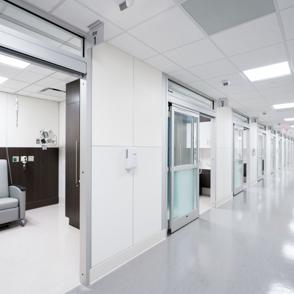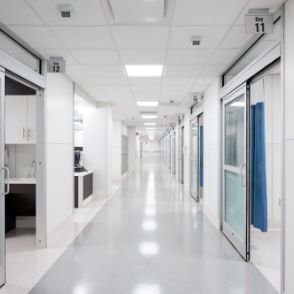Standardised healthcare products are the backbone of efficient, safe and functional healthcare environments. Products like bed heads, modular walls and pressurised pods play a crucial role in ensuring healthcare spaces run smoothly.
Knowing this, we’d like to help you explore why standardised healthcare products matter and how they help create environments that can adapt to future technologies and challenges.
What are Standardised Healthcare Products?
Standardised healthcare products refer to essential components designed to meet defined specifications and functionality requirements. These products are built to be reliable, cost-effective and adaptable to various healthcare environments. Standardised products ensure that healthcare spaces have consistent features that meet safety, regulatory and operational needs, offering multiple strategic advantages, such as:
– Consistent quality control
– Simplified maintenance procedures
– Faster installation processes
– Reduced long-term operational costs
– Enhanced patient safety protocols
The Role of Standardised Healthcare Products in Healthcare Spaces
Efficiency and Consistency
One of the primary benefits of using standardised healthcare products is efficiency. By using products that are designed to a set specification, healthcare facilities can maintain consistency across different areas of the building. For example, the design of bed heads is widely standardised, in accordance with the HTMs, to provide essential utilities like medical gases, lighting, power and data, which makes it easier for healthcare staff to access them when needed.
In modular systems like ours, integrated bedheads and modular walls are all designed to fit seamlessly, ensuring that the space functions efficiently from day one. This consistency helps streamline workflows, reduce errors and improve overall efficiency.
Compliance and Safety
Standardisation ensures that healthcare spaces meet essential safety and regulatory standards. Many healthcare regulations require specific products to be standardised, especially when it comes to infection control, accessibility and safety. For instance, ventilation systems, sink modules and clean rooms must meet infection control guidelines to maintain hygiene and minimise cross-contamination.
Standardised healthcare products must provide durability and resilience, ensuring that they continue to function safely and effectively in demanding healthcare environments. This reduces the risk of malfunctions and ensures that healthcare professionals can rely on the products during critical moments.
Time and Cost Efficiency
From an economic perspective, the standardisation of products offers significant time and cost savings through economies of scale. By reducing variability and enabling mass production, these products are quicker to construct, easier to maintain and update and simpler to use across multiple locations. Healthcare facilities can invest in high-quality infrastructure without incurring excessive customisation lead times and expenses.
Moreover, standardised products simplify staff training, reduce equipment replacement complexity, and create predictable maintenance schedules.
The Architectural Wallsz Way:
At Architectural Wallsz, we understand the importance of using standardised healthcare products to meet the practical needs of healthcare spaces. However, we also believe in offering flexibility. Our modular systems are designed to incorporate the benefits of standardised manufacturing processes while offering the adaptability that modern healthcare environments require.
Our modular walls are designed in accordance with Hospitals’ comprehensive regulations, pre-integrated with standardised services that ensure quick and easy installation, but they can also be reconfigured or expanded as healthcare needs change. Our bed heads and sanitary wall modules integrate essential functions like power, medical gases and plumbing in a way that can be easily replicated throughout the entire facility while maintaining flexibility to adapt to different room configurations.
The Big Difference Standardised Healthcare Products Make
Technological Integration and Futureproofing
As medical technology continues to evolve at an unprecedented pace, standardised healthcare products serve as critical infrastructure for technological integration. By providing consistent, reliable foundations, these products enable healthcare facilities to:
– Rapidly incorporate new medical technologies
– Minimise disruption during equipment upgrades
– Ensure compatibility across different medical systems
– Create scalable, adaptable healthcare environments
The Broader Impact on Healthcare Delivery
Standardised healthcare products ultimately contribute to a more efficient, safe and patient-centred healthcare ecosystem. They represent a strategic approach to medical environment design that prioritises both immediate functionality and long-term adaptability.
Conclusion: Standardised Does Not Mean Ordinary
Standardised healthcare products are far more than background infrastructure. They are strategic assets that define the quality, safety and efficiency of modern medical spaces.
From our side, we are keen on demonstrating that true innovation in healthcare design lies in creating flexible and responsive systems that anticipate and meet any complex needs that patients and staff may need.






Sorry, the comment form is closed at this time.